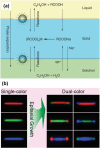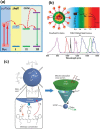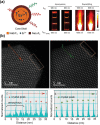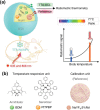Recent Progress of Rare-Earth Doped Upconversion Nanoparticles: Synthesis, Optimization, and Applications
- PMID: 31763145
- PMCID: PMC6865011
- DOI: 10.1002/advs.201901358
Recent Progress of Rare-Earth Doped Upconversion Nanoparticles: Synthesis, Optimization, and Applications
Abstract
Upconversion is a nonlinear optical phenomenon that involves the emission of high-energy photons by sequential absorption of two or more low-energy excitation photons. Due to their excellent physiochemical properties such as deep penetration depth, little damage to samples, and high chemical stability, upconversion nanoparticles (UCNPs) are extensively applied in bioimaging, biosensing, theranostic, and photochemical reactions. Here, recent achievements in the synthesis, optimization, and applications of UCNP-based nanomaterials are reviewed. The state-of-the-art approaches to synthesize UCNPs in the past few years are introduced first, followed by a summary of several strategies to optimize upconversion emissive properties and various applications of UCNPs. Lastly, the challenges and future perspectives of UCNPs are provided as a conclusion.
Keywords: NIR light; optimization; rare earth; synthesis; upconversion.
© 2019 The Authors. Published by WILEY‐VCH Verlag GmbH & Co. KGaA, Weinheim.
Conflict of interest statement
The authors declare no conflict of interest.
Figures

















References
-
- Leiner M. J. P., Anal. Chim. Acta 1991, 255, 209.
-
- Roda A., Guardiglia M., Pasinia P., Mirasoli M., Michelini E., Musiani M., Anal. Chim. Acta 2005, 541, 25.
-
- Sagara Y., Kato T., Nat. Chem. 2009, 1, 605. - PubMed
-
- Valeur B., Berberan‐Santos M. N., Molecular Fluorescence Principles and Applications, Wiley‐VCH, Weinheim: 2012.
-
- Bloembergen N., Phys. Rev. Lett. 1959, 2, 84.
Publication types
LinkOut - more resources
Full Text Sources
Other Literature Sources
Miscellaneous
